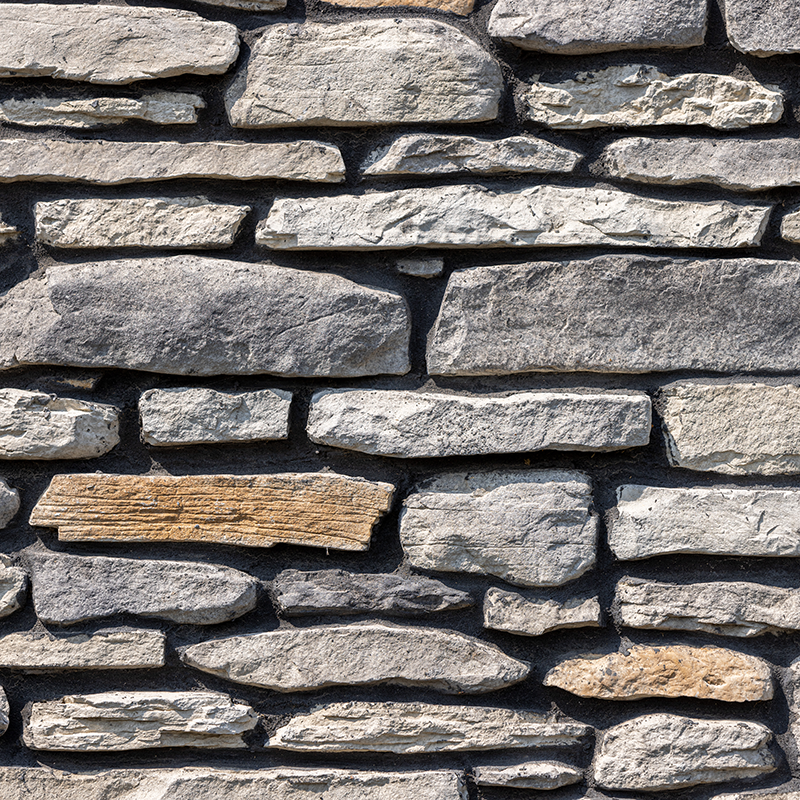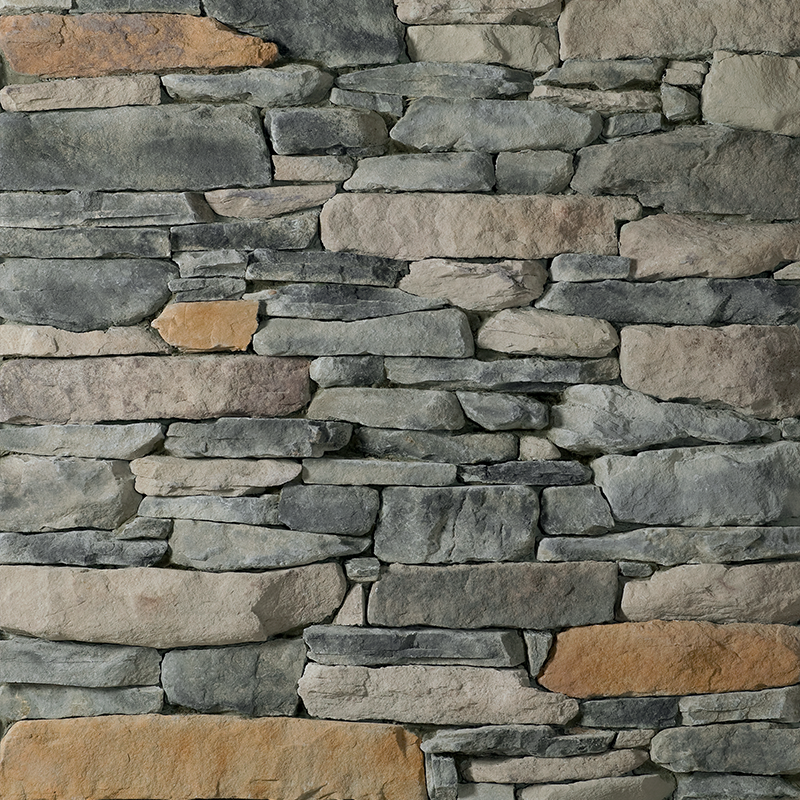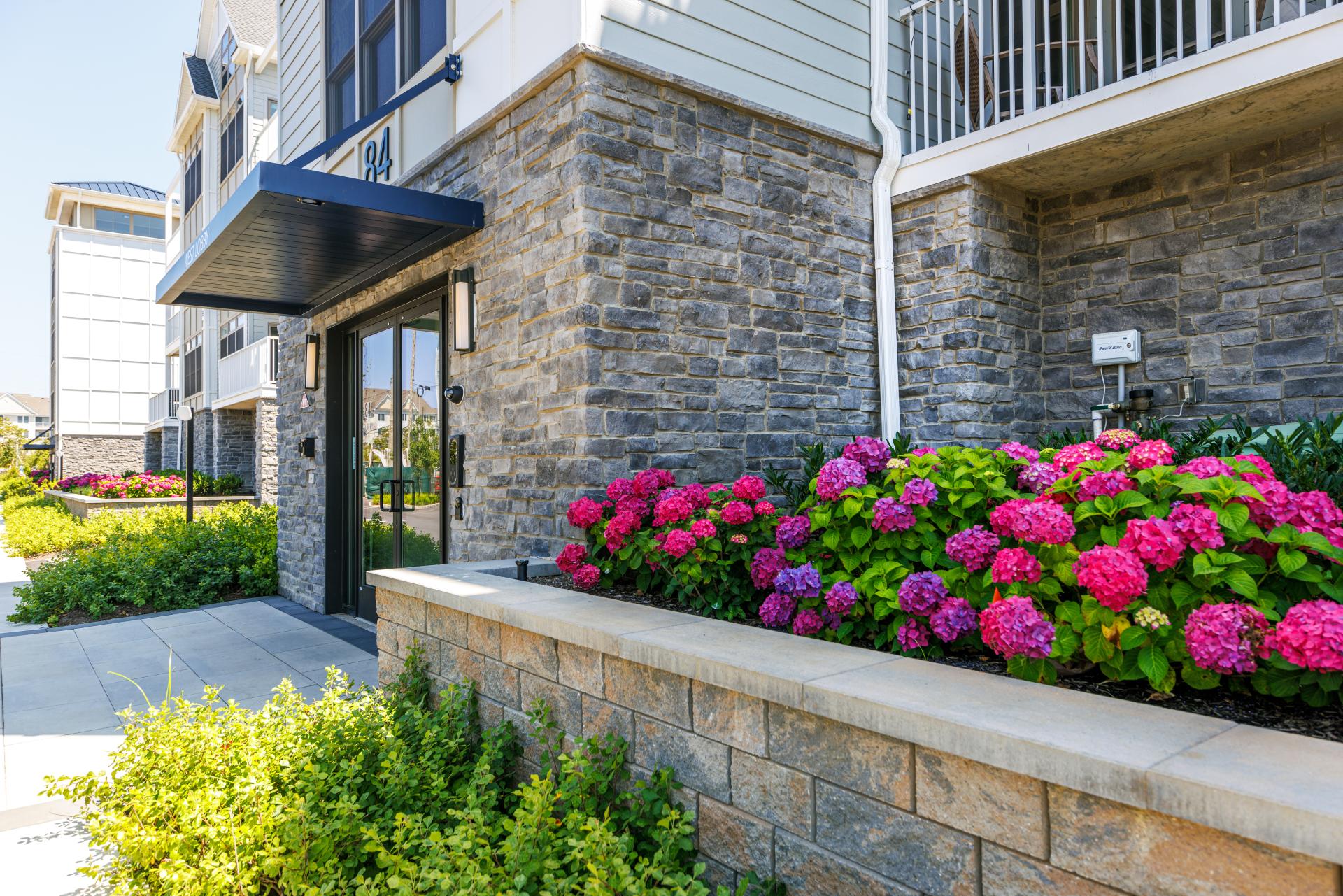February 21, 2024
Stone Installation: to Mortar or Not to Mortar?
Throughout history, stone has remained an essential construction material. The strength and incredible durability of stone make it a preferred choice of building products for supporting a structure’s weight and withstanding the elements.
Beyond its supreme functionality, stone also offers an aesthetic appeal unmatched by many materials, making it beloved by architects and designers. With a full range of colors and textures, stone provides an eye-catching addition to the exterior and interior of many homes.
When it comes to installation, stone can be installed to create a mortared or mortarless look. For a mortared look, builders install the stone with mortar layers or joints between each stone highlighting the mixture of shapes. For a mortarless look, builders can use a dry stacked technique, carefully positioning stone pieces on top of each other so that they appear to be laid without any grout. Mortared stone is sturdier and will remain in place over time. Dry stacked stone relies more heavily on gravity and precision, and may be more susceptible to popping out of place.
Choosing to mortar or not to mortar depends on your budget, where the project is located, and how it will mesh with the rest of the home’s design.
Where Can You Use Stone?
Builders use stone in creative ways throughout the home, both inside and out. In the interior of the home, you’ll find stone often featured in the following ways:
- To frame a fireplace
- As an accent wall
- As a kitchen backsplash
- On a kitchen island front
- To define a threshold or doorway arch
On the exterior of the home, stone can be used to:
- Contrast or complement a brick wall
- Decorate a chimney
- Create an accent wall
- Complement a doorway
The Verdict: to Mortar or Not to Mortar
In the end, when deciding whether to mortar or not to mortar, consider:
- Is the project on the exterior or interior of the home? If the project is on the outside of the home, go with mortared stone so it lasts longer. If the project is on the home’s interior and not susceptible to harsh weather conditions, mortared stone or dry stacked stone will have a similar lifespan. In this instance, the choice will then depend on the desired design aesthetic.
- What other design elements will surround the project? Choosing whether or not to mortar depends on the home’s overall design profile. Is it classic? Mortared stone with wide joints looks more traditional. Is it contemporary? Mortared stone with narrow joints looks more modern. Is it farmhouse-style? Dry stacked stone evokes a more rustic look and feel.
- How much do you want to spend? Dry stacking will be a more labor-intensive installation, and thus cost more to install. For budget-conscious builders, mortar may be the better option.

When To Mortar
Mortared stone is typically less expensive to install than dry stacking. With mortared stone, builders have more control over the look of the project and can make it stand out or blend in as much as possible.
If your project will be on the exterior of the home, mortared joints will withstand stronger to harsh weather conditions and the typical wear and tear of nature’s elements over time. The mortar will help reduce moisture retention, prevent insects, and keep the stones in place.
Beyond functionality, mortaring offers more options to create a unique look, whether complementary or as a bold statement through use of thin or thick mortar, application technique, and color choices. A mortared stone wall can be a dramatic accent or a complementary frame, depending on the width of the joints, shape of the stone, and color of the mortar.

When Not To Mortar
Dry stacking requires more labor and thus may come at a higher installation cost. From precisely cutting the stone so it lays properly, to carefully placing it, this process may also take longer than the application of a mortared stone. The thinner the stone, the more it will cost to cut.
Dry stacking works better indoors, as it will naturally have some spacing between the stones that is not conducive to preventing moisture and keeping insects out. Dry stacked stone may also shift naturally as it reacts with the elements, which could lead to a compromise in the structural integrity of the element being built with stone. In some instances, some mortar may still be used to hold the stone in place. To maintain a dry stacked appearance in this instance, use of a thicker stone is recommended since it can hide the slight use of mortar.
With dry stacked stone, builders also have less control over what the finished product will look like, since the stone will have to fit together to create an interlocking pattern. However, for some projects, a more natural appearance that celebrates the beauty of imperfection is ideal for the aesthetic.
Dry stacked stone is a popular choice for framing fireplaces, defining the threshold or entryway of the home, or as an accent wall. It also blends seamlessly with design profiles like the popular modern farmhouse.
Find Your Store
IA | Des Moines
-
4601 NW Urbandale Drive, Suite 112
Urbandale, Iowa 50322
- Phone: 515-219-7842
- Hours: 07:30 am - 04:00 pm
IL | Bridgeview
-
7542 West 73rd Street
Bridgeview, Illinois 60455
- Phone: 708-607-9430
- Hours: 07:00 am - 03:00 pm
IL | Champaign
-
3200 W. Springfield
Champaign, Illinois 61822
- Phone: 217-439-4348
- Hours: 07:00 am - 03:30 pm
IL | Chicago
-
850 W. Pershing Road
Chicago, Illinois 60609
- Phone: 773-923-3771
- Hours: 07:00 am - 03:00 pm
IL | Des Plaines
-
821 Seegers Road
Des Plaines, Illinois 60016
- Phone: 847-860-6806
- Hours: 07:00 am - 03:00 pm
IL | Naperville
-
1760 North Aurora Road
Naperville, Illinois 60563
- Phone: 630-864-5711
- Hours: 07:00 am - 03:00 pm
IL | New Lenox
-
1300 West Maple Street
New Lenox, Illinois 60451
- Phone: 815-680-2971
- Hours: 07:00 am - 03:00 pm
IL | Schaumburg
-
409 West Wise Road
Schaumburg, Illinois 60193
- Phone: 847-860-6242
- Hours: 07:00 am - 03:00 pm
IL | Springfield
-
800 South 9th Street
Springfield, Illinois 62703
- Phone: 217-492-8544
- Hours: 07:30 am - 03:00 pm
IN | Carmel
-
430 West Carmel Drive
Carmel, Indiana 46032
- Phone: 317-597-8767
- Hours: 07:30 am - 04:00 pm
IN | Chesterton
-
1631 Pioneer Trail
Chesterton, Indiana 46304
- Phone: 219-250-9859
- Hours: 07:30 am - 04:00 pm
IN | Evansville
-
3401 Mt Vernon Ave
Evansville, Indiana 47712
- Phone: 812-993-4472
- Hours: 08:00 am - 04:00 pm
IN | Fort Wayne
-
3000 N Wells St
Fort Wayne, Indiana 46808
- Phone: 260-264-7468
- Hours: 07:30 am - 04:00 pm
IN | Indianapolis Edgewood North
-
5007 W 96th St
Indianapolis, Indiana 46268
- Phone: 317-751-2334
- Hours: 08:00 am - 04:30 pm
IN | Indianapolis Epler Ave
-
1580 E Epler Ave
Indianapolis, Indiana 46227
- Phone: 317-779-1670
- Hours: 07:30 am - 04:00 pm
IN | Indianapolis Shelby St
-
5518 Shelby Street
Indianapolis, Indiana 46227
- Phone: 317-779-3090
- Hours: 08:00 am - 04:30 pm
IN | Lafayette
-
1799 North 9th Street
Lafayette, Indiana 47904
- Phone: 765-476-0452
- Hours: 07:30 am - 04:00 pm
IN | South Bend
-
918 Oliver Plow Ct
South Bend, Indiana 46601
- Phone: 574-777-0167
- Hours: 07:30 am - 04:00 pm
MD | Baltimore
-
4150 Hayward Avenue
Baltimore, Maryland 21215
- Phone: (410) 220-2363
- Hours: 07:00 am - 04:00 pm
MD | Upper Marlboro (DC)
-
8315 Old Marlboro Pike
Upper Marlboro, Maryland 20772
- Phone: (301) 701-5160
- Hours: 07:30 am - 04:00 pm
MI | Waterford
-
6315 Highland Road
Waterford, Michigan 48327
- Phone: 248-392-3980
- Hours: 07:00 am - 03:30 pm
MI | Whitmore Lake
-
6556 Whitmore Lake Rd
Whitmore Lake, Michigan 48189
- Phone: 734-212-8454
- Hours: 08:00 am - 04:00 pm
MN | Bloomington
-
520 West 86th Street
Bloomington, Minnesota 55420
- Phone: 952-206-5490
- Hours: 07:30 am - 04:00 pm
NE | Omaha
-
13801 Industrial Road
Omaha, Nebraska 68137
- Phone: 402-235-5567
- Hours: 07:30 am - 04:00 pm
PA | Reading
-
200 Hartman Road
Muhlenberg, Pennsylvania 19605
- Phone: 610-686-7711
- Hours: 07:00 am - 03:30 pm
VA | Manassas
-
7413 Cushing Road, Suite 100
Manassas, Virginia 20109
- Phone: 703-263-8057
- Hours: 07:00 am - 03:30 pm

